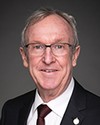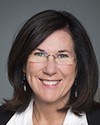I'd like to introduce myself to the committee, tell you a bit about my relationship with David, how I got to know him and what prompted me to submit my proposal to do this research. I want to give you a bit of the background and some of the methodology of how I conducted my research and wrote the report. Basically, I'd like to furnish the committee with a lot of things that you wouldn't necessarily get just from reading the report itself.
I met David in the summer before I started law school at Osgoode. As a blind law student, I thought it would behoove me to reach out to a blind lawyer and ask for some tips and tricks of the trade as I started my legal education. He said that he had about 15 minutes to meet me between the meeting he had at Osgoode and a plane he had to catch. About half of that meeting took place in the halls and the elevator at Osgoode. I realized then that David was a very busy, very effective and efficient person, making use of every spare minute of time.
Throughout my time at Osgoode, I experienced many challenges. Interestingly, to the best of my knowledge, I was the first fully blind student to attend at Osgoode since David Lepofsky had graduated in 1979. They had other visually impaired students, but there are some unique challenges to being completely blind. Most notably, I use a screen reader.
The school had a recorded lecture policy available to the students, but unfortunately, it had been mounted on a platform where you needed a mouse button to click the play button. I worked with the techies at Osgoode, at York University, at Microsoft itself, for months. There was really no workaround, and the only way to do it was to change the platform that the school was using.
Ironically, about 10 years before I started my studies, Osgoode had also undergone a major renovation. It was aesthetically very pleasing. People commented on how open the floor design was and how they had made great use of natural light. Unfortunately, they had also compromised the accessibility of the law school, not just for visually impaired people, but they also sacrificed some wheelchair accessibility.
Most notably, and somewhat disturbingly, is that many of the classrooms have an intricate staircase system that goes from the back to the front. It's difficult for anyone to navigate, let alone anybody with some challenges. It presupposes that nobody in a wheelchair would need to access the front of the class to speak to a professor, but even more disturbingly, that nobody with a disability would be at the front of the class as a professor. This sort of exclusion of thinking about people in positions of power as having a disability is part of the stigma that advocates like Mr. Lepofsky and I are fighting very hard to change.
So, I started a student-run organization at Osgoode. I called it the Daredevils in Training Organization.
Although originally we focused a lot on visual impairments, we lobbied on behalf of all students with a disability. We were successful at convincing the administration to change the way that they mounted their recorded lecture policy, so I was able to make use of those lectures in second and third year. Another student who was with me at the time also appreciated that.
We also worked with them on the physical structure of the space, and that was ongoing when I left. They were putting in tactile wayfinding, and seeing what they could do about the wheelchair situation, certainly with the acknowledgement that something needed to be done.
When I was in second year going into third year and looking at internships and other opportunities available, I noticed this Centennial Flame Research Award. I couldn't think of somebody who would be more fitting to write about than David Lepofsky, so with his support and the support of Roxanne Mykitiuk, who was a professor at Osgoode who supported my application, I submitted my proposal.
I, of course, knew about David's work with the Constitution, the Charter, Supreme Court decisions, the Attorney General and, of course, his infamous work with regard to the TTC. What I didn't realize was the amount of work that he's actually done with this committee. It must have been a bit surprising to see his name on that application. Certainly, he met the criteria, surpassed it in so many ways and definitely deserved to have this honour.
My methodology really focused on a few interviews with David, although I'd heard him speak many times before. He's actually given more guest lectures than some of the professors whose courses I actually took. I just wanted to flesh out my understanding a little bit more with some one-on-one time with him. This was something that I approached him about before submitting my proposal. I wanted to make sure that, if I was approved, it wouldn't come as a surprise to him that I was now expecting so many hours of his very valuable time.
Following those interviews, I then read his collected works and engaged in this endeavour of noting up David Lepofsky to see how he had been referenced by other academics. I came up with an overwhelming plethora of journal articles, chapters in textbooks—both legal and sociological—Supreme Court decisions and decisions from other tribunals. In the end, I had to pick a very small handful of what was available to get the general picture of how his work was being received within the wider community.
With all of this research and knowledge in hand, I expanded my focus of interviews to the people who had worked with David Lepofsky over the years. I interviewed a number of professors at Osgoode and a few people who had worked with Barrier-Free Canada and other organizations that he'd been involved with. I also talked to Jerome Bickenbach, who was a little surprised to hear somebody asking about an article that he'd written about 30 years ago. Nonetheless, I felt it was a really important part of the process, and it gave me a really good idea of David's character and how he worked with other people.
It was really important for me to see that relationship of how David worked with other people because, in this report, what I really wanted to mostly do was furnish advocates with tools that they could use to help with their own advocacy endeavours. This piece is, in many ways, a mini biography about David Lepofsky and his work. As he's been very inspirational to me, I wanted to be very inspirational to other advocates. Beyond just providing inspiration, I wanted to provide that education and provide a model that some aspiring advocates could take if they were interested in establishing another organization or advancing their own advocacy initiatives in some way. I didn't just present the model. I also tried to break that down into its individual elements and show how these components interact so that aspiring advocates could then pick and choose which aspects of Lepofsky's work they would want to incorporate in their own initiatives.
For instance, one thing that was very important—and I'm hoping this came through clearly in the report—was having a simplified organizational structure. This is a strong part of David's philosophy, and it's something that I strongly agree with. I've been involved in a number of organizations, and I've seen many of the challenges involved with regard to the organizational structure. Keeping it simple, I think, was just the best way to go, and I'm hoping that this came across. I also tried to focus a little bit on some of the foibles to give this a little bit of a human spin and also to maintain that inspiration to advocates in their moments of failure. You're not going to win every single battle.
I felt it was important to look at what doesn't work, and why it didn't work and how it didn't work, to help people avoid some of their own trial and error. Also, it was to illustrate that the strategies and tactics that worked well in one situation may not work in another situation. That may not be the fault of the advocate, but just the circumstances of the situation. I wanted to really provide people with something they could take away and use to advance their own advocacy. I'm hoping that came through in the report. I'm really looking forward to the publication of this on the website. I have to get that link to my mom, because she wants to put it on Facebook.




